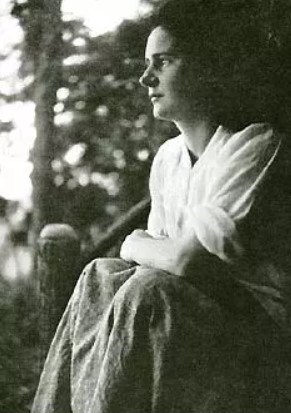|
_______________________________________________________
#7 19 May 2024
Portrait of Lilian Steichen in her 20s by her brother, Edward Steichen (ca.1916) .From the Carl Sandburg Papers at the Carl Sandburg Home National Historic Site.
Dream Girl Lilian Steichen
By John W. Quinley
Dear Readers, You might wonder where Lilian Steichen and Carl
Sandburg met for the first time? It was at the headquarters of the
Social-Democratic Party in Milwaukee. Carl was an up-and-coming organizer for
the southern district of Wisconsin and Lilian was a part-time translator of
German and French socialist tracts. She declined when Carl asked her out for
dinner but did agree that he could write to her to share his socialist articles.
He slipped a few poems into his first mailing, including “The Dream Girl.”
Lilian replied, “My hope is that socialism will gradually create an environment
favorable to the development of such a Millennial Dream Girl. But meanwhile
under capitalism your Dream-Girl must be a leisure class product.” Soon, they
were writing letters to each other, dozens of them. At a time when it was rare for a female to continue
education past grammar school, she attended the University of Illinois and
graduated from the University of Chicago as Phi Beta Kappa with Honors in
English and Latin. She started a career in teaching: first as an instructor at a
normal school in North Dakota, and then as an English and Latin teacher at a
high school in northern Illinois. Lilian and Carl married in
1908. They vowed to live a life of social action. She wrote, “I
wasn’t meant to waste my life on a becalmed sail-boat! I was made to be a
sailor-girl on rough seas with a proud sailor-boy, glad of the high wind and the
work of sailing our vessel true!” They also committed to share a simple life
unencumbered by things unimportant. Carl wrote Lilian (who was now using the
name Paula) that: All the big people are simple, as simple as the
unexplored wilderness. They love the universal things that are free to
everybody. Light and air and food and love and some work are enough. In the
varying phases of these cheap and common things, the great lives have found
their joy. After receiving more rejection letters from publishers
than they could count, Carl might have given up on his poetry without Paula’s
insistence that he continue. As their family grew to three daughters, she kept a
place in their home quiet so he could work and took care of the girls while Carl
was on the road lecturing, reading poems, and singing folk songs. After he rose
to the height of fame, she shielded him from the many people who vied for his
attention. She kept the books, read all his works, assisted in scheduling
appearances, and sometimes proofed drafts for publication. It wasn’t until the family moved to Michigan in 1927,
that Paula had an interest independent from Carl’s—raising goats. The Sandburg’s
intentionally moved to their Connemara Farm in Flat Rock, North Carolina in 1945
to expand the herd. She continued her practice of carefully recording the type
and amount of feed, breeding decisions, and resulting births. Her goats won
numerous honors from their showings at local and state fairs throughout the
South. She published articles in goat journals and made speeches at conferences
and agricultural schools—talking with folks who often as not had never heard of
Carl Sandburg. She also helped establish the American Dairy Goat Association and
served as its director for over ten years. In 1960, a Sandburg goat was
internationally recognized as the top producing doe in the world. Weighing 170
pounds, the goat produced more than two gallons of milk per day—her weight in
milk every week. The record stood for two decades. Paula became Carl’s dream girl in so many ways. In his
poem, “The Great Hunt,” he writes:
Thanks for reading,
John Quinley is the author of Discovering Carl
Sandburg: The Eclectic Life of an American Icon and is a former docent at
the Carl Sandburg Home National Historic Site in Flat Rock, North Carolina.
| |||||||||||||||||||||||||||||||

